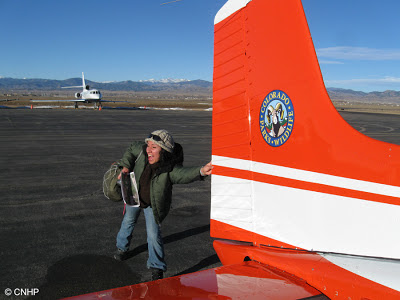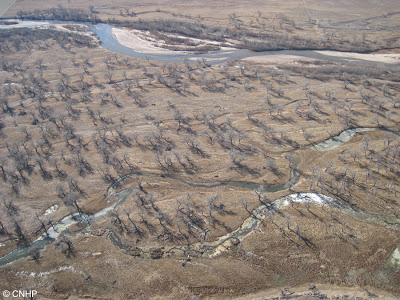by Jeremy Sueltenfuss, CNHP Wetland Ecologist
For many years, our partners in the wildlife community have
talked at length about the importance of warm water sloughs for overwintering
Colorado wildlife. As they are
continually recharged by emerging groundwater, which is not subjected to the
freezing temperatures at the surface, these stream-like features are some of
the only water bodies across the landscape that remain open throughout the
winter, providing wildlife much needed access to water during the cold winter
months. Because of their importance, we
set out to map all the sloughs we could find along the South Platte River. While aerial imagery can be quite good at
mapping water features, nothing beats a low altitude flight to get a sense of
the landscape!
talked at length about the importance of warm water sloughs for overwintering
Colorado wildlife. As they are
continually recharged by emerging groundwater, which is not subjected to the
freezing temperatures at the surface, these stream-like features are some of
the only water bodies across the landscape that remain open throughout the
winter, providing wildlife much needed access to water during the cold winter
months. Because of their importance, we
set out to map all the sloughs we could find along the South Platte River. While aerial imagery can be quite good at
mapping water features, nothing beats a low altitude flight to get a sense of
the landscape!
 |
| Though familiar with the more common method of flying (being inside the plane that is), Jacqui thought she would give this method a shot. It did not last long. An immense thanks to Colorado Parks and Wildlife for supplying us with their plane and the CPW pilot, Brian, for a very safe and rewarding experience. |
Taking off in a small four seat prop plane from the Fort
Collins – Loveland airport (Fort Love as our pilot referred to it), Jacqui, a
fearless CNHP work-study student and I put our faith in our pilot, Brian. Brian has been flying for Colorado Parksand Wildlife (CPW) for years, and his knowledge of both the landscape and local
wildlife was tremendously beneficial.
Beyond his ability to spot herds of deer, gaggles of geese, and flocks
of turkey from amazing distances, his stories from his work for CPW were
breathtaking. While I love hiking to
remote mountain lakes, I have never thought about what it takes to stock them
with fish. Brian’s stories of
maneuvering his small plane through tight mountain corridors, dropping his air
speed to levels I personally never wish to feel while in flight, and releasing
hundreds of small fish at precisely the right moment for them to land in the
lake, all while watching the rock face in front of you fill your vision, was
enough to make me sweat. Luckily for us,
the only aerial acrobatics we performed were slow broad circles to get a closer
look at a slough, or a better view of some wildlife.
Collins – Loveland airport (Fort Love as our pilot referred to it), Jacqui, a
fearless CNHP work-study student and I put our faith in our pilot, Brian. Brian has been flying for Colorado Parksand Wildlife (CPW) for years, and his knowledge of both the landscape and local
wildlife was tremendously beneficial.
Beyond his ability to spot herds of deer, gaggles of geese, and flocks
of turkey from amazing distances, his stories from his work for CPW were
breathtaking. While I love hiking to
remote mountain lakes, I have never thought about what it takes to stock them
with fish. Brian’s stories of
maneuvering his small plane through tight mountain corridors, dropping his air
speed to levels I personally never wish to feel while in flight, and releasing
hundreds of small fish at precisely the right moment for them to land in the
lake, all while watching the rock face in front of you fill your vision, was
enough to make me sweat. Luckily for us,
the only aerial acrobatics we performed were slow broad circles to get a closer
look at a slough, or a better view of some wildlife.
 |
| Continually being recharged by groundwater, warm water sloughs remain slightly warmer than other surface waters and remain open throughout the winter. This provides much needed access to water for wildlife in the area. |
Though “Colorful Colorado” is quite brown in the winter,
flying at 150 feet over the South Platte was fascinating and beautiful. As promised, sloughs seemed to be the only
open water around, and the leafless trees afforded views of the many flocks of
waterbirds, small herds of deer bounding away, and even a few scenes of male
turkeys doing their best to impress a nearby female. The seven bald eagles we saw perched in trees
or soaring above the river provided a wonderful example of an Endangered
Species Act success story and served as tribute to the tremendous effort of conservation
groups over the past 50 years. It was
enough to almost forget what we were after!
Armed with maps of sloughs we had completed before the flight using
imagery from the summer, we constantly compared what was in our maps to what we
were seeing on the ground. Both Jacqui
and Brian seemed to do quite well looking down at maps and back out at the
landscape for 4 straight hours. While I
did my best to appear absolutely normal, my stomach was reenacting what it must
feel like to stock those high mountain lakes!
Queasiness aside, we accomplished our goal and came away with a highly
accurate map of the warm water sloughs along the South Platte River between
Greeley and the state line. Though many
other riparian landscapes across the state contain warm water sloughs that may
one day be mapped, I have high hopes this data can be used for the restoration
and the conservation of lands containing these important features.
flying at 150 feet over the South Platte was fascinating and beautiful. As promised, sloughs seemed to be the only
open water around, and the leafless trees afforded views of the many flocks of
waterbirds, small herds of deer bounding away, and even a few scenes of male
turkeys doing their best to impress a nearby female. The seven bald eagles we saw perched in trees
or soaring above the river provided a wonderful example of an Endangered
Species Act success story and served as tribute to the tremendous effort of conservation
groups over the past 50 years. It was
enough to almost forget what we were after!
Armed with maps of sloughs we had completed before the flight using
imagery from the summer, we constantly compared what was in our maps to what we
were seeing on the ground. Both Jacqui
and Brian seemed to do quite well looking down at maps and back out at the
landscape for 4 straight hours. While I
did my best to appear absolutely normal, my stomach was reenacting what it must
feel like to stock those high mountain lakes!
Queasiness aside, we accomplished our goal and came away with a highly
accurate map of the warm water sloughs along the South Platte River between
Greeley and the state line. Though many
other riparian landscapes across the state contain warm water sloughs that may
one day be mapped, I have high hopes this data can be used for the restoration
and the conservation of lands containing these important features.




